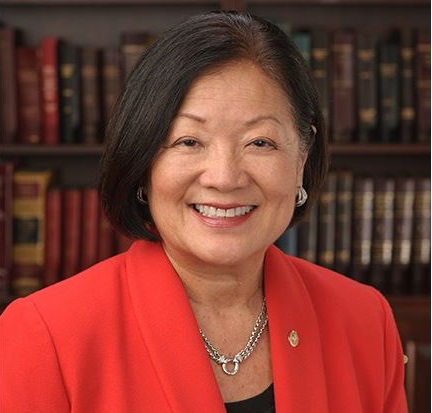June 04, 2019
From Senator Hirono’s Remarks:
“Hawaii is on the leading edge of incorporating renewable power and energy storage. Of course, Hawaii is not connected to any other state’s grid, we’re kind of on our own.
“I visited the Lawai Solar and Storage Facility on Kauai Island in Hawaii in April. It is the largest combined solar and battery storage facility in the world. It generates 11 percent of Kauai’s power and can serve as much as much as 40 percent of Kauai’s evening peak power demand. Altogether, Kauai Island Utility Cooperative gets 50 percent of its power from renewable sources, and it expects to reach 60 percent renewable power by the end of this year with another combined solar and battery storage system at Pacific Missile Range Facility, Barking Sands Naval Base.
“Hawaiian Electric…recently received approval for six new solar and storage projects to provide 247 megawatts of solar energy with almost 800 megawatt hours of storage – enough to power 105,000 homes per year while eliminating the use of more than 48 million gallons of imported fossil fuel. Hawaii was the most imported fossil fuel dependent state in the country, and we had probably the highest electricity rates in the country, possibly with the exception of Alaska.
“The company is preparing a second round of bids for even more solar and storage to replace fossil fuel plants. There will be even more innovation in the future to meet Hawaii’s goal of 100 percent renewable power by 2045.”
Senator Hirono is a co-sponsor of S. 1593, the Promoting Grid Storage Act of 2019, to research, develop, and deploy energy storage systems, including assistance to local organizations identify and design energy storage systems. She is also a co-sponsor of S. 1142, the Energy Storage Tax Incentive and Deployment Act of 2019, which would provide a 30 percent credit for the purchase of energy storage systems. In May, Senator Hirono joined her colleagues in introducing S.1288, the Clean Energy for America Act, which would reform the federal tax code as part of a plan to support a low-carbon economy by consolidating the current 44 energy incentives into three technology-neutral provisions that encourage clean electricity, clean transportation, and energy efficiency while repealing tax incentives for fossil fuel companies
Hirono: “Hawaii is on the Leading Edge of Incorporating Renewable Power and Energy Storage”
Highlights Work of KIUC and Hawaiian Electric to Deploy Renewable Energy Plus Storage Facilities Across Hawaii at Senate Energy Committee Hearing Focused on How Energy Storage Can Reduce Carbon Emissions
WASHINGTON, D.C. – Senator Mazie K. Hirono (D-Hawaii) highlighted the efforts of Kauai Island Utility Cooperative (KIUC) and Hawaiian Electric to deploy renewable energy plus storage facilities across the state at a Senate Energy and Natural Reurces Committee hearing on energy storage today. Senator Hirono also spoke about her visit to the Lawai Solar Energy Plus Storage Facility on Kauai in April. Currently the largest solar generation plus storage project in the world, the Lawai facility generates 11 percent of Kauai’s power and can serve as much as 40 percent of Kauai’s evening peak power demand.From Senator Hirono’s Remarks:
“Hawaii is on the leading edge of incorporating renewable power and energy storage. Of course, Hawaii is not connected to any other state’s grid, we’re kind of on our own.
“I visited the Lawai Solar and Storage Facility on Kauai Island in Hawaii in April. It is the largest combined solar and battery storage facility in the world. It generates 11 percent of Kauai’s power and can serve as much as much as 40 percent of Kauai’s evening peak power demand. Altogether, Kauai Island Utility Cooperative gets 50 percent of its power from renewable sources, and it expects to reach 60 percent renewable power by the end of this year with another combined solar and battery storage system at Pacific Missile Range Facility, Barking Sands Naval Base.
“Hawaiian Electric…recently received approval for six new solar and storage projects to provide 247 megawatts of solar energy with almost 800 megawatt hours of storage – enough to power 105,000 homes per year while eliminating the use of more than 48 million gallons of imported fossil fuel. Hawaii was the most imported fossil fuel dependent state in the country, and we had probably the highest electricity rates in the country, possibly with the exception of Alaska.
“The company is preparing a second round of bids for even more solar and storage to replace fossil fuel plants. There will be even more innovation in the future to meet Hawaii’s goal of 100 percent renewable power by 2045.”
Senator Hirono is a co-sponsor of S. 1593, the Promoting Grid Storage Act of 2019, to research, develop, and deploy energy storage systems, including assistance to local organizations identify and design energy storage systems. She is also a co-sponsor of S. 1142, the Energy Storage Tax Incentive and Deployment Act of 2019, which would provide a 30 percent credit for the purchase of energy storage systems. In May, Senator Hirono joined her colleagues in introducing S.1288, the Clean Energy for America Act, which would reform the federal tax code as part of a plan to support a low-carbon economy by consolidating the current 44 energy incentives into three technology-neutral provisions that encourage clean electricity, clean transportation, and energy efficiency while repealing tax incentives for fossil fuel companies
###
